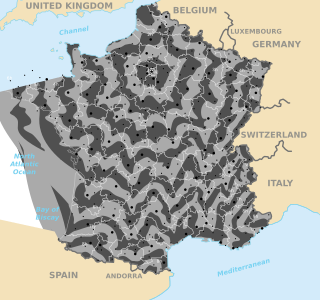
Transportation in France relies on one of the densest networks in the world with 146 km of road and 6.2 km of rail lines per 100 km2. It is built as a web with Paris at its center. Rail, road, air and water are all widely developed forms of transportation in France.
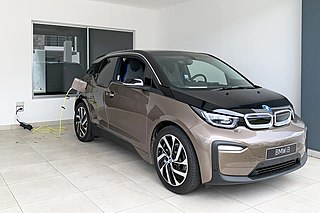
An electric vehicle (EV) is a vehicle that uses one or more electric motors for propulsion. The vehicle can be powered by a collector system, with electricity from extravehicular sources, or can be powered autonomously by a battery or by converting fuel to electricity using a generator or fuel cells. EVs include road and rail vehicles, electric boats and underwater vessels, electric aircraft and electric spacecraft.
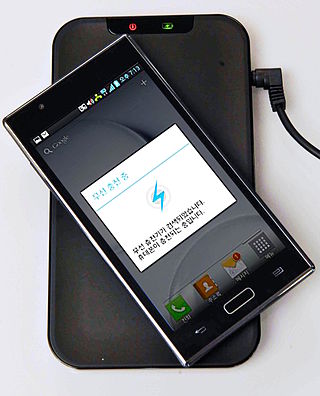
Wireless power transfer (WPT), wireless power transmission, wireless energy transmission (WET), or electromagnetic power transfer is the transmission of electrical energy without wires as a physical link. In a wireless power transmission system, an electrically powered transmitter device generates a time-varying electromagnetic field that transmits power across space to a receiver device; the receiver device extracts power from the field and supplies it to an electrical load. The technology of wireless power transmission can eliminate the use of the wires and batteries, thereby increasing the mobility, convenience, and safety of an electronic device for all users. Wireless power transfer is useful to power electrical devices where interconnecting wires are inconvenient, hazardous, or are not possible.
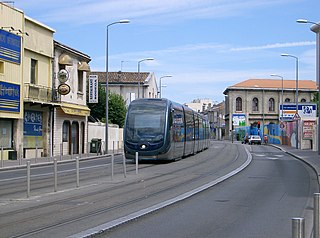
Ground-level power supply, also known as surface current collection or, in French, alimentation par le sol, is a concept and group of technologies whereby electric vehicles collect electric power at ground level from individually-powered segments instead of the more common overhead lines. Ground-level power supply was developed for aesthetic reasons, to avoid the presence of overhead lines in city centres.

An electric bus is a bus that is propelled using electric motors, as opposed to a conventional internal combustion engine. Electric buses can store the needed electrical energy on board, or be fed mains electricity continuously from an external source such as overhead lines. The majority of buses using on-board energy storage are battery electric buses, where the electric motor obtains energy from an onboard battery pack, although examples of other storage modes do exist, such as the gyrobus that uses flywheel energy storage. When electricity is not stored on board, it is supplied by contact with outside power supplies, for example, via a current collector, or with a ground-level power supply, or through inductive charging.
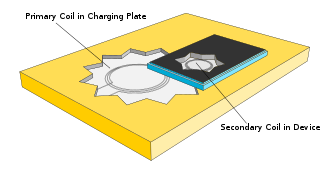
Inductive charging is a type of wireless power transfer. It uses electromagnetic induction to provide electricity to portable devices. Inductive charging is also used in vehicles, power tools, electric toothbrushes, and medical devices. The portable equipment can be placed near a charging station or inductive pad without needing to be precisely aligned or make electrical contact with a dock or plug.

A battery electric bus is an electric bus that is driven by an electric motor and obtains energy from on-board batteries. Many trolleybuses use batteries as an auxiliary or emergency power source.

A charging station, also known as a charge point, chargepoint, or electric vehicle supply equipment (EVSE), is a power supply device that supplies electrical power for recharging plug-in electric vehicles.

Trams in France date from 1837 when a 15 km steam tram line connected Montrond-les-Bains and Montbrison in the Loire. With the development of electric trams at the end of the 19th century, networks proliferated in French cities over a period of 15 years. Although nearly all of the country's tram systems were replaced by bus services in the 1930s or shortly after the Second World War, France is now in the forefront of the revival of tramways and light rail systems around the globe. Only tram lines in Lille and Saint-Étienne have operated continuously since the 19th century; the Marseille tramway system ran continuously until 2004 and only closed then for 3 years for extensive refurbishment into a modern tram network. Since the opening of the Nantes tramway in 1985, more than twenty towns and cities across France have built new tram lines. As of 2024, there are 28 operational tram networks in France, with 3 more planned. France is also home to Alstom, a leading tram manufacturer.
Smart highways and smart roads are highways and roads that incorporate electronic technologies. They are used to improve the operation of connected and autonomous vehicles (CAVs), for traffic lights and street lighting, and for monitoring the condition of the road, as well as traffic levels and the speed of vehicles.

Resonant inductive coupling or magnetic phase synchronous coupling is a phenomenon with inductive coupling in which the coupling becomes stronger when the "secondary" (load-bearing) side of the loosely coupled coil resonates. A resonant transformer of this type is often used in analog circuitry as a bandpass filter. Resonant inductive coupling is also used in wireless power systems for portable computers, phones, and vehicles.
Plugless Power is a family of Electric Vehicle Supply Equipment (EVSE) products manufactured by Plugless Power, Inc. that enable wireless (inductive) charging for electric vehicles (WCEV). The Plugless Power EVSE wirelessly delivers electrical power to the on-board EV battery charger using electromagnetic induction without a physical connection (cable) to the vehicle. An EV equipped with a Plugless Vehicle Adapter can be charged by parking it over an inductive Plugless Parking Pad. The active step of plugging a cord into the vehicle is eliminated.
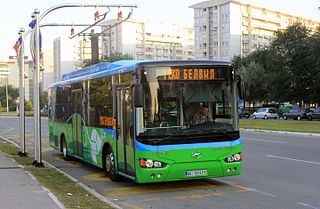
A capacitor electric vehicle is a vehicle that uses supercapacitors to store electricity.

On-Line Electric Vehicle or OLEV is an electric vehicle system developed by KAIST, the Korea Advanced Institute of Science and Technology, which charges electric vehicles wirelessly while moving using inductive charging. Segments composed of coils buried in the road transfer energy to a receiver or pickup that is mounted on the underside of the electric vehicle, which powers the vehicle and charges its battery.
Road powered electric vehicles (RPEV) collect any form of potential energy from the road surface to supply electricity to locomotive motors and ancillary equipment within the vehicle.

Conductive charging is conductive power transfer that replaces the conductive wires between the charger and the charged device with conductive contacts. Charging infrastructure in the form of a board or rail delivers the power to a charging device equipped with an appropriate receiver, or pickup. When the infrastructure recognizes a valid receiver it powers on, and power is transferred.
SAE J2954 is a standard for wireless power transfer (WPT) for electric vehicles led by SAE International. It defines three classes of charging speed, WPT 1, 2 and 3, at a maximum of 3.7 kW, 7.7 kW and 11 kW, respectively. This makes it comparable to medium-speed wired charging standards like the common SAE J1772 system. A much more powerful WPT9 is being defined in J2954/2 for 500 kW charging for heavy-duty vehicles which have the room necessary to mount the larger induction plate.

SAE J3105 is a recommended practice for automated connection devices (ACD) that mate chargers with battery electric buses and heavy-duty vehicles. The practice is maintained by the SAE International with the formal title "Electric Vehicle Power Transfer System Using Conductive Automated Connection Devices Recommended Practice", and was first issued in January 2020. It covers the general physical, electrical, functional, testing, and performance requirements for automated conductive DC power transfer systems intended for heavy duty vehicles, focusing primarily on transit buses.

Alstom APS, also known as Alimentation par Sol or Alimentation Par le Sol, is a form of ground-level power supply for street trams and, potentially, other vehicles. APS was developed by Innorail, a subsidiary of Spie Enertrans, but was sold to Alstom when Spie was acquired by Amec. It was originally created for the Bordeaux tramway, which was constructed from 2000 and opened in 2003. From 2011, the technology has been used in a number of other cities around the world.
The Swedish Transport Administration electric road program or Swedish Transport Administration Electrification Program is a program involving the assessment, planning, and implementation of an electric road national infrastructure for Sweden by Trafikverket, the Swedish Transport Administration.


















